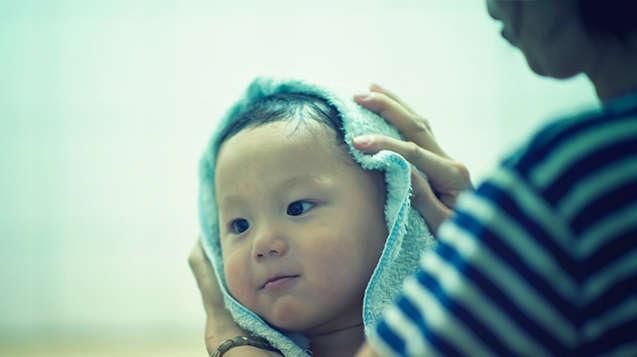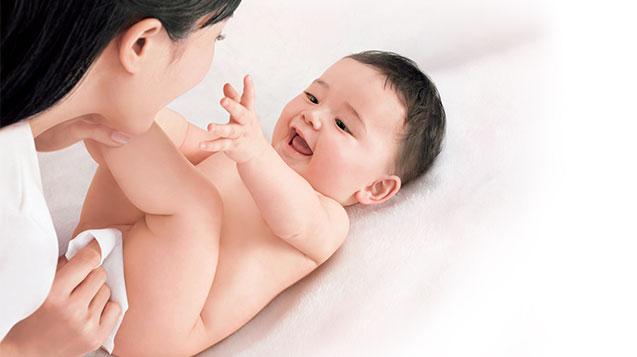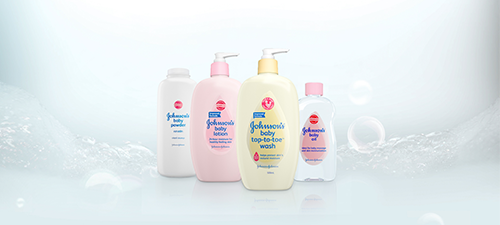
Ingredients
Each of the ingredients in JOHNSON’S® products is included for a specific purpose.
These are the ingredients used in JOHNSON’S® products globally. Not all of them may be found in the products available in Singapore.
We use the legally required INCI (International Nomenclature of Cosmetic Ingredients) nomenclature to describe each ingredient on the label, but we realize they’re not all household names. If you’re curious about what each ingredient does or why it’s included, take a look at our color coded ingredient list.
- Purple –Adds color to the product
- Blue– helps cleanse skin and/or hair
- Orange – helps cleanse skin and/or hair
- Green – helps maintain product thickness
- Red – adds moisture to skin and hair
- Dark Blue – helps maintain product freshness
- Gold – helps adjust pH levels
- Pink – helps keep the product mixed together
- Grey – helps absorb moisture
- A
- Acrylates Copolymer
- Acrylates/C10-30 Alkyl Acrylate Crosspolymer
- Aloe Barbadensis Leaf Extract
- Avena Sativa (Oat) Kernel Flour
- B
- Behentrimonium Chloride
- Behentrimonium Methosulfate
- Behenyl Alcohol
- Blue 1
- Butyrospermum Parkii (Shea Butter)
- C
- Carbomer
- Ceteareth-6
- Cetearyl Alcohol
- Cetearyl Glucoside
- Cetrimonium Chloride
- Cetyl Alcohol
- Cetyl Hydroxyethylcellulose
- Citric Acid
- Cocamidopropyl Betaine
- Coco-Glucoside
- Cocoglycerides
- Cotton
- D
- Decyl Glucoside
- Dicaprylyl Carbonate
- Dicaprylyl Ether
- Dimethicone
- Disodium Lauroamphodiacetate
- E
- Ethylhexylglycerin
- Ext. Violet 2
- F
- Fragrance/Parfum
- G
- Glycerin
- Glyceryl Oleate
- Glyceryl Polyacrylate
- Glyceryl Stearate
- Glycine Soja (Soybean) Oil
- Glycol Distearate
- Guar Hydroxypropyltrimonium Chloride
- H
- Hexyl Laurate
- Hydrogenated Cottonseed Oil
- Hydrogenated Palm Glycerides
- Hydrogenated Styrene/Isoprene Copolymer
- Hydroxyethyl Behenamidopropyl Dimonium Chloride
- I
- Isopropyl Palmitate
- J
- K
- L
- Laureth-4
- Lauryl Alcohol
- Lauryl Glucoside
- Lauryl Methyl
- Gluceth-10 Hydroxypropyldimonium Chloride
- M
- Magnesium Aluminum Silicate
- Mineral Oil
- N
- O
- P
- p-Anisic Acid
- PEG-150 Distearate
- PEG-40 Hydrogenated Castor Oil
- PEG-80 Sorbitan Laurate
- Pentaerythrityl Tetraditbutyl Hydroxyhydrocinnamate
- Pentasodium Pentetate
- Phenoxyethanol
- Polyglyceryl-10 Laurate
- Polyglyceryl-2 Dipolyhydroxystearate
- Polyquaternium-10,
- Polyquaternium-7, Polyquaternium-37
- Polysorbate 20
- Potassium Acrylates Copolymer
- Propylene Glycol
- Propylene Glycol Dicaprylate/Dicaprate
- Q
- R
- Red 33
- S
- Sodium Benzoate
- Sodium Chloride
- Sodium Citrate
- Sodium Cocoate
- Sodium Coco-Sulfate
- Sodium Cocoyl Isethionate
- Sodium Hydroxide
- Sodium Laureth Sulfate
- Sodium Lauroamphoacetate
- Sodium Lauryl Sulfoacetate
- Sodium Palm Kernelate
- Sodium Palmate
- Sodium Tallowate
- Sodium Trideceth Sulfate
- Stearic Acid
- Stearyl Alcohol
- T
- Talc
- Tetrasodium EDTA
- Theobroma Cacao (Cocoa) Seed Butter
- Tocopheryl Acetate (Vitamin E)
- Tricalcium Phosphate
- Trideceth-6, Trideceth-9
- Trisiloxane
- U
- V
- Violet 2
- W
- Water
- X
- Xanthan Gum
- Y
- Yellow 10
- Yellow 6
- Z
- Zea Mays (Corn) Starch

Selecting the safer preservatives
Preservatives have gotten a bad rap lately, but they play an important role in product safety.
Think of preservatives as ingredients that prevent spoilage—just like with some foods, we need them to help keep products fresh, preventing mold or bacteria from growing in them. In fact, without some type of preservative system, you’d have to throw away your product after only a few weeks to prevent it from getting moldy or risk bacterial infection.
JOHNSON’S® takes a lot of care in figuring out the best way to preserve our products so they stay safe. There are lots of preservatives approved for use by regulatory agencies worldwide (estimated more than 60), but only a small number meet all of our strict requirements for babies.
Every preservative ingredient we use must pass a five-level safety assurance process as well as the JOHNSON’S® BEST FOR BABY™ Standard for safety. When selecting preservatives, we also adhere to other safety steps, including:
- Ongoing review of the most up-to-date research and available data on preservative ingredients.
- Identifying potential factors that may have an impact on the effectiveness and safety of the product's use, including how it will be used and where it will be stored.
- Evaluating all suppliers of our ingredients to ensure they conform to our high standards for quality and safety.
For more information about the role preservatives play in keeping products safe, take a look at this video.

Your Ingredients Questions Answered
We are here for you.
You can write to us, share your photos with us, complain to us, ask us for advice–and we are here to help. And no question is a bad question, especially when it comes to care and concern for your baby. So go ahead and ask us about whatever’s on your mind. To get things started, here are a few questions we have received recently. For more answers to commonly asked questions, take a look at our MythConception video series.
Q.What are essential oils and are they okay to use on my baby?
A.An essential oil is a thick liquid that contains the base aroma of a plant. It is used as a fragrance in many consumer products. While essential oils are natural and may sometimes be safe for adults, they also contain allergens and can be irritants to baby’s skin, so they don’t pass JOHNSON’S® safety requirements or testing. JOHNSON’S® does not use essential oils in our baby products.
Q.I noticed that some of the natural baby care products I was looking at in the store were different colors and sort of different textures, too. Why is that?
A.This is related to the concept of ‘product shelf-life’. Sometimes, a baby shampoo or baby wash can sit in a store for a few weeks before you take it home and use it. If you observe any separation, discoloration or an unusual odor, it is best to contact the manufacturer first before deciding whether to use it on your baby.
Q.I assume if something costs more it must be better and have better ingredients. Is this true?
A.Unfortunately, cost does not necessarily mean that a product has better or safer ingredients. At JOHNSON’S®, we believe in charging fair prices to continue to make safe products available for all moms and babies.
What questions do you have? Send us an email to [email protected] and check back here for the answer.
Our 3-step bedtime routine is clinically proven to help children aged 7 to 36 months sleep better in just 1 week.
Identify, prevent and treat diaper rash with this helpful guide from DESITIN®, the #1 choice of pediatricians and moms.*
*In the USA. Based on Wolters Kluwer 2Q 2008 Brand Management Reports (Diaper Rash) and Diaper Rash Category Dollar Share of Segment, May 2007.
Explore all of JOHNSON’S® baby products or use our product filters to narrow your search, helping you find just what you’re looking for—fast.
Moms around the world trust JOHNSON’S® to care for their babies
We are committed to working with moms, healthcare experts and scientists to ensure our products continue achieving the highest standards in safety, quality and care.







